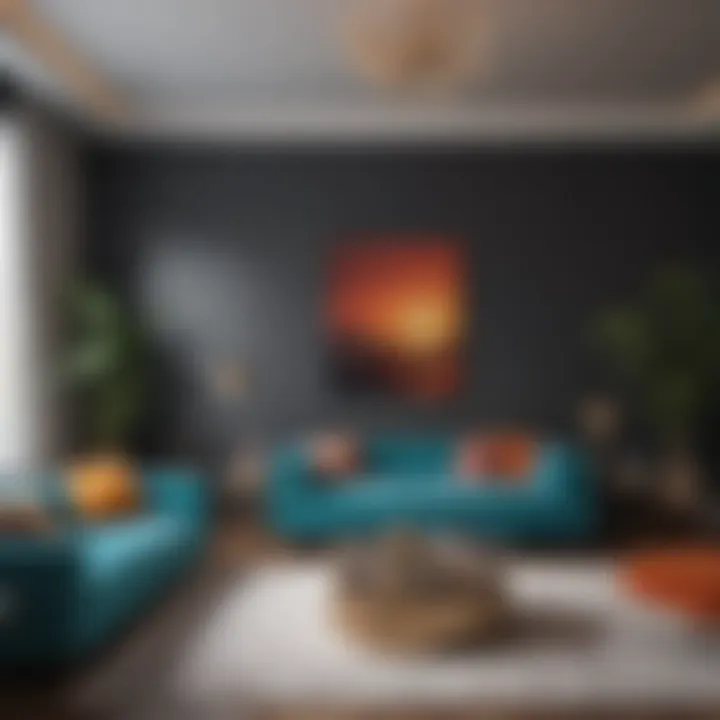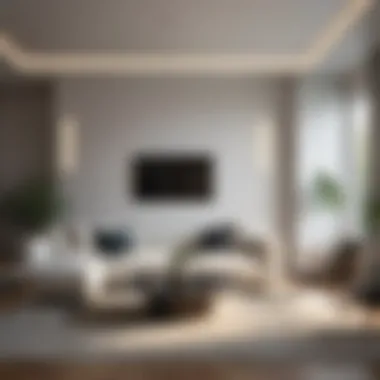Innovative Living Room Interior Design Ideas


Intro
In the realm of interior design, the living room stands as a focal point. It serves not only as a gathering place but also reflects personal style and creativity. Homeowners are constantly seeking ways to enhance their living spaces, marrying functionality with aesthetic appeal. This article delves into innovative design ideas that blend current trends with timeless concepts. Readers will gain insights into color palettes, furniture configurations, and personalized decor, all tailored to inspire thoughtful renovations.
Design Inspirations
Trending Styles
The first step to reimagining your living room is understanding what styles resonate with your aesthetic preferences. Modern minimalism emphasizes clean lines and neutral colors, making spaces feel more open. Meanwhile, Scandinavian design integrates warmth through natural materials and simple forms. Bohemian decor brings in vibrant textures and patterns, creating a cozy yet eclectic atmosphere. For those considering a vintage twist, mid-century modern incorporates retro furniture and a playful use of color. Choosing the right style can set the foundation for the entire space.
Color Palettes
Color significantly impacts mood and perception in a living room. Soft pastels can evoke tranquility, while bold hues like emerald green or navy blue can energize the space. A popular choice is the use of monochromatic schemes, where varying shades of one color create depth and continuity. Additionally, incorporating accent colors can add visual interest without overwhelming the design. It is crucial to test paint samples and fabric swatches in different lighting to better envision the final outcome.
"Color is the keyboard, the eyes are the harmonies, the soul is the piano with many strings."
– Wassily Kandinsky
Maintenance and Upkeep
Seasonal Maintenance Checklist
Maintaining the beauty and functionality of a living room goes beyond the initial design phase. A seasonal checklist can help keep the space looking fresh. Items often include:
- Inspecting furniture for damages
- Shampooing rugs and carpets
- Dusting hard-to-reach areas
- Updating decorations for the season
These tasks not only preserve aesthetics but also enhance the comfort and longevity of the room.
Cleaning and Organization Tips
A well-organized living room can elevate the overall feel of the space. Start by decluttering, removing unnecessary items that distract from your design. Invest in multifunctional furniture such as ottomans with storage or coffee tables with drawers. Regular cleaning is essential; consider adopting a routine that includes dusting surfaces, vacuuming, and laundering throw pillows and blankets. These simple practices ensure the living room remains a welcoming oasis.
In summary, innovative living room designs are a blend of personal taste and current trends. With careful selection of styles and colors, along with diligent maintenance, homeowners can create spaces that are both functional and visually appealing. As the cornerstone of the home, a thoughtfully designed living room can enhance not just aesthetics but also the overall quality of life.
Understanding Living Room Design
Understanding living room design is essential for creating a space that is not only visually appealing but also functional. The living room often serves as the heart of a home, where families gather, guests are entertained, and personal moments are shared. A well-designed living room can enhance the comfort of these interactions and improve the overall atmosphere of a home.
When exploring living room design, one must consider several key elements. These include layout, color schemes, furniture selection, and lighting. Each of these factors contributes to the overall ambiance and usability of the space.
Moreover, incorporating innovative or unique ideas into living room design can set a home apart. Whether through eclectic furnishings, a specifically chosen color palette, or the use of sustainable materials, each design choice reflects personal style and preferences. These choices not only improve aesthetics but can also boost the functionality of the living room, making it suitable for various activities.
With this in mind, understanding living room design benefits homeowners and design enthusiasts by offering insight into trends and practices that prioritize both beauty and utility.
The Role of the Living Room
The living room plays a pivotal role in any home. It functions as a social hub, offering space for gatherings, relaxation, and entertainment. The design of this area should cater to its multifunctional nature. This means prioritizing comfort and accessibility, ensuring that furniture arrangements encourage conversation, and that the decor reflects the personality of the homeowners. An inviting living room sets the tone for the entire house and influences how residents and guests interact.
Key Design Principles
To create a successful living room, certain design principles should be adhered to. These principles help in achieving a cohesive and thoughtful space. Three foundational design principles include scale and proportion, balance and harmony, and focal points.
Scale and Proportion
Scale and proportion dictate how elements of the living room fit together. This principle is crucial because it directly influences comfort and aesthetics. For example, large sofas can overwhelm a small space, making it feel cramped. Conversely, tiny furniture in a vast space may feel lost and uninviting.
The key characteristic of scale and proportion is ensuring that each piece of furniture relates well to others and the room itself. This makes it a beneficial choice for creating a well-designed living room. A unique feature arises when one considers the use of oversized art or accessories. In the right context, they can add interest and anchor the space. However, inconsistency in scale may lead to a disjointed look.
Balance and Harmony
Balance and harmony work together to create a sense of equilibrium in the living room. They are vital in achieving visual stability. Balance can be symmetrical or asymmetrical. Symmetrical designs tend to create formal environments, while asymmetrical arrangements offer a more casual feel.
One prominent characteristic of balance is its ability to produce a pleasing effect through proper arrangement of furnishings and decor. It provides a sense of order that makes living rooms feel comfortable and cohesive. When designing a living room, paying attention to symmetry or introducing varied pieces is advantageous. However, poor balance can result in discomfort or distraction in the space.
Focal Points
Focal points in a living room direct the eye and create interest. They can be architectural details, art pieces, striking furniture, or even a fireplace. A well-placed focal point can anchor the room and establish a specific mood or theme.
This principle is beneficial because it allows homeowners to showcase elements they find appealing or important. The unique feature of a focal point is its potential to influence the entire arrangement of the room. While a strong focal point can enhance a space, several competing focal points can clutter the room's appearance, detracting from its overall effect.
"A well-designed living room reflects the unique taste of its inhabitants while also catering to the needs of those who occupy it."
In summary, understanding the design principles of scale and proportion, balance and harmony, and focal points is essential. They provide a framework for creating a living room that is both beautiful and practical.
Contemporary Design Trends
Contemporary design trends in living rooms represent a fusion of modern aesthetics and functionality. These trends shift with the times but often focus on simplicity, utility, and innovation. They aim to create spaces that are not only beautiful but also practical for everyday use. Embracing contemporary design means acknowledging the evolving needs of homeowners, combining comfort and style seamlessly.
Simplicity is at the heart of contemporary design. Various styles complement this ethos, such as minimalism and maximalism. Understanding these styles allows homeowners to make informed decisions that reflect their tastes and lifestyles. Additionally, incorporating technology into design has become increasingly prevalent, emphasizing the importance of integrating smart solutions for enhanced living experiences.


Minimalism in the Living Room
Minimalism is a key aspect of contemporary living room design. It emphasizes the idea of “less is more,” focusing on essential elements while eliminating the superfluous. This approach creates an open and airy atmosphere that enhances clarity and peace of mind. Minimalist spaces use clean lines, neutral colors, and functional furniture, which contribute to a calming environment.
The benefits of minimalism include making a room appear larger and more organized. It encourages intentional choices regarding decor and furniture, fostering a sense of mindfulness in how space is utilized. For those living in smaller homes or apartments, minimalism can provide a profound sense of liberation from clutter.
Maximalist Approaches
Maximalism, on the other hand, celebrates richness and abundance. It allows for personal expression through bold colors, extravagant patterns, and diverse styles. This approach encourages layering and mixing different elements, creating an inviting and stimulating environment.
Layering Textures
Layering textures is a fundamental character of the maximalist approach. This technique enhances depth and visual interest in the living room. By combining various fabrics, finishes, and surfaces, one can create a tactile experience that draws attention.
The unique feature of layering textures is its ability to evoke emotion and warmth in a space. By opting for textiles like velvet, linen, or natural fibers can significantly enhance the room's atmosphere. However, be mindful that too many competing textures can lead to visual chaos, so balance is essential.
Eclectic Furnishings
Eclectic furnishings allow homeowners to curate a unique style that reflects personal experiences and tastes. This approach encourages the inclusion of items from various historical periods, cultures, and styles. It’s particularly beneficial for creating a narrative within the living room, showcasing significant pieces alongside playful additions.
The key characteristic of eclectic furnishings is their diversity, which can make a space feel lived-in and eclectic. While this creates vibrancy and character, it is important to ensure that the combination is cohesive. Disregarding harmony can make the living room feel disjointed.
"Contemporary design trends reflect the changing needs of society. They blend comfort with aesthetics."
Incorporating both minimalism and maximalism into living room design can create a balance of styling. Depending on personal preferences, each can significantly influence the overall ambiance, combining functionality with innovative visual appeal.
Color Schemes and Effects
Color schemes play a vital role in designing a living room. They set the tone for the space, influencing mood and perception. Selecting the right colors may enhance comfort while also reflecting personal style. Choosing appropriate colors can unite different design elements, creating harmony. The benefit of a well-considered color scheme is clear; it can make or break the overall aesthetic of the living room.
Choosing a Color Palette
When selecting a color palette, consider both personal preferences and the room's purpose. Soft hues often create a serene environment, while bold colors can energize the space. Look at how colors interact with light at different times of day. This interaction can change the perception of the palette significantly. Research current color trends, but also trust your own instincts about what feels right in your home.
The Psychology of Color
Warm vs. Cool Colors
Warm colors like red, orange, and yellow bring energy into a room. They can create a sense of intimacy and warmth, making spaces feel inviting. A living room with warm colors can promote conversation and a sense of togetherness. On the other hand, cool colors such as blue, green, and purple tend to have a calming effect. They can create a tranquil atmosphere, ideal for relaxation after a long day. The choice between warm and cool colors often depends on the desired energy of the room, so understanding their effects is important.
Neutral Tones
Neutral tones like beige, gray, and taupe provide versatility in design. They serve as a blank canvas for more vibrant accents and can enhance other features in the room. Neutral colors can also evoke a sense of timeless style. A living room dominated by neutral tones can be easily updated with decor changes. However, one downside is they may result in a space feeling bland without additional visual interest. It is essential to add textures and patterns in accents to bring life to a neutral color scheme.
Accent Walls and Textures
Accent walls offer a practical approach for adding character without overwhelming a space. They can be a focal point, guiding the eye and creating depth. Consider using wallpaper, paint, or different materials to create an accent wall. Textures such as wood or brick add dimension, making the room feel layered and engaging. Balance is crucial; too many textures can clutter the space.
Conclusion: Incorporating color schemes and effects is vital in achieving a harmonious and inviting living room. The right palette, along with strategic use of warm and cool colors or neutrals, can dramatically influence the overall feel of the space. Accent walls provide an opportunity for creativity, making interior design a more personal experience.
Furniture Selection and Arrangement
Furniture selection and arrangement plays a critical role in defining the living room's overall atmosphere. The right furniture choices not only enhance aesthetic appeal but also improve functionality. When selecting furniture, consider the scale, style, and how pieces complement the room's design. Effective arrangement maximizes space and facilitates movement, contributing to a convivial environment.
Sofa Styles and Arrangements
Sectionals
Sectionals are versatile pieces that embody both comfort and style. Their adaptability allows them to fit into various room layouts, making them a popular choice. One key characteristic of sectionals is their potential to create a cozy seating area without occupying excessive space. This is particularly beneficial in smaller living rooms where efficient use of square footage is essential.
What sets sectionals apart is their ability to encourage interaction among guests. The unique configuration options enable homeowners to tailor the design to their needs, whether it be a U-shape for intimate gatherings or an L-shape for everyday use. However, it is important to consider that sectionals may be challenging to rearrange, should you wish to change the room's layout.
Chesterfields
Chesterfields represent a timeless elegance, captivating with their distinctive upholstery and historical charm. This style stands out due to its tufted back and rolled arms, making it a sophisticated addition to many living rooms. Chesterfields fit well in both traditional and modern settings, appealing to diverse tastes.
Their luxurious presence can elevate the overall design of a living room, serving as a statement piece that draws attention. Although Chesterfields may require more space compared to lighter furniture options, they offer substantial comfort and a sense of refinement. They are best positioned in areas where their design can be appreciated, enhancing the living room's character.
Multifunctional Furniture
In an age of compact living spaces, multifunctional furniture is increasingly important. These pieces serve various purposes, helping to maximize functionality without sacrificing style. For example, coffee tables with storage can declutter the living space, while sofas that can convert into beds offer convenience for guests.
Additionally, ottomans that can double as seating and footrests provide flexibility for various activities. When selected thoughtfully, multifunctional furniture can adapt to changing needs, proving to be a strategic investment for homeowners.
Creating Conversation Areas
Creating conversation areas is a vital aspect of furniture arrangement. Arranging seating to face each other promotes social interaction and openness. This setup is particularly effective during gatherings, as it encourages engagement among guests.
Consider using rugs to define conversation zones within the living room. This not only adds warmth but also visually separates areas for diverse activities. Use a mix of furniture heights and sizes to create an inviting space. By being intentional with furniture layout and design, you can cultivate an immersive environment.


Lighting Solutions
Lighting is a vital aspect of living room design that goes beyond mere functionality. It influences the mood, enhances the aesthetic appeal, and affects how space is perceived. When designed well, it can create a warm, inviting atmosphere while highlighting the room’s decor and furniture. Understanding the different forms of lighting and their appropriate usage is essential for any homeowner or designer aiming to create an appealing living environment.
Natural Light Utilization
Natural light can transform a space. It is an effective way to enhance the beauty of a living room while reducing the need for artificial lighting. Windows and openings allow sunlight to enter, making the space feel more expansive and vibrant. When designing a living room, consider the orientation of windows. South-facing windows bring in the most light, while north-facing windows provide softer, diffused illumination.
To maximize natural light:
- Use reflective surfaces like mirrors and glossy finishes to bounce light around the room.
- Choose lighter colors for walls and ceilings, which can amplify the effects of natural light.
- Keep window treatments minimal or opt for sheer curtains to filter light without blocking it entirely.
Layering Light Sources
Effective lighting often requires a combination of different types of light. This method is known as layering light, which consists of three main categories: ambient, task, and accent lighting. Here’s a closer look at each one:
Ambient Lighting
Ambient lighting provides overall illumination. This general lighting ensures a comfortable level of brightness throughout the room. It is typically achieved through ceiling fixtures, such as chandeliers or flush mounts. The key characteristic of ambient lighting is its ability to create a uniform light distribution in the space, making it suitable for everyday activities.
This type of lighting is beneficial as it:
- Offers a welcoming glow, helping to set the tone for the room.
- Minimizes harsh shadows, enhancing visibility.
However, one unique feature is that ambient lighting can sometimes be insufficient for specific tasks, requiring additional light sources to complement it.
Task Lighting
Task lighting serves a specific function. It illuminates areas where activities, such as reading or working, take place. This type of lighting often includes table lamps, floor lamps, and under-cabinet lights in a living room.
Its primary advantage lies in providing focused illumination, which helps reduce eye strain during tasks. One important factor to consider is the brightness level, which should be adjustable based on the activity. Task lighting is popular as it enhances functionality in a space, especially for multi-purpose living rooms.
Accent Lighting
Accent lighting adds character to a living room, showcasing design elements like artwork or architectural features. It is generally more focused and can create visual interest by directing attention to specific areas or objects. Common examples include spotlights, wall sconces, or even strategically placed floor lamps.
The main characteristic of accent lighting is its ability to create depth and highlight details. It adds layers to the overall lighting scheme. However, while accent lighting contributes to the decor and atmosphere, it should be used judiciously to avoid overwhelming the space.
"Lighting is not just a utility function; it’s an integral part of design that enhances the living experience."
Incorporating Textiles
In every successful living room design, textiles play a crucial role. They bring warmth and texture to otherwise rigid spaces, enhancing both aesthetic appeal and comfort. This section explores how various textiles can transform a living room into a welcoming retreat. The choice of fabrics can affect the overall mood of the room, making it easier to create a desired ambiance. Additionally, incorporating different textiles allows for personalization and the expression of individual style.
Choosing Fabrics for Comfort
Comfort is paramount in a living room, as this is where one often relaxes or entertains guests. Selecting the right fabrics can significantly enhance this aspect. Soft materials, like cotton or linen, provide a pleasant tactile experience, while durable fabrics like microfiber resist wear and tearing.
When choosing fabrics, consider their maintenance and usability. Some fabrics stain easily, while others are machine washable. Ideally, select textiles that fit both your lifestyle and the intended use of the space. For example, a family with children and pets might benefit from stain-resistant upholstery fabrics, whereas a more formal setting might allow for silk or velvet.
Layering Soft Furnishings
Layering is an effective way to add depth and coziness to a living room. By combining different textiles, one can create a more inviting and visually appealing environment.
Cushions and Throws
Cushions and throws are essential for layering soft furnishings. They serve not only as decorative pieces but also enhance comfort. The variety of colors, patterns, and textures available means that there are endless possibilities for customization.
The key characteristic of cushions and throws is their versatility. They can easily be switched out or rearranged to suit seasonal themes or personal preferences. This adaptability makes them a beneficial choice for dynamic living spaces. However, one must consider potential over-cluttering that can inadvertently undermine a room's design.
"Properly chosen cushions and throws can significantly enhance comfort and style in any living room."
Rugs
Rugs also contribute significantly to the overall textile narrative within a living room. They define spaces, add warmth underfoot, and can serve as the foundation for the room's color scheme. Different materials, from wool to synthetic fibers, provide unique benefits. For example, wool rugs are durable and naturally stain-resistant, making them suitable for high-traffic areas.
The key characteristic of rugs is their ability to anchor the space while adding visual interest. A distinctive rug can be the focal point of a living room, guiding the arrangement of other furnishings. However, one must be careful choosing sizes; a rug that is too small can make a space feel disjointed.
Personalization and Accessorizing
Personalizing and accessorizing a living room is crucial in creating a space that reflects the homeowner's identity and style. It transforms a room from a mere functional area into a personalized sanctuary. Thoughtful accessories can enhance the warmth and character of the living room, making it inviting and unique. Personal touches allow individuals to tell their story through design, showcasing personal interests, travels, and artistic tastes.
Artwork and Decor
Artwork and decor elements play a pivotal role in personalizing a living room. They introduce color, texture, and emotion into the space. Choosing art that resonates with the homeowner's personality elevates the overall atmosphere. For instance, an abstract painting can inject energy, while a serene landscape can add tranquility. It is essential to balance artwork with other design elements. A well-placed piece can become a focal point, drawing attention and stimulating conversation.
Incorporating Plants


Incorporating plants into the living room design not only adds aesthetic value but also contributes to the well-being of residents. Plants purify the air and create a serene environment, enhancing mental health.
Indoor Plants
Indoor plants are a cornerstone of modern living room decor. They breathe life into the space and improve air quality, making them a beneficial choice. Common options like peace lilies or snake plants require minimal maintenance and thrive indoors. Their varied shapes and sizes can fit into diverse design schemes, from minimalist to bohemian. Indoor plants also offer a refreshing visual contrast against metal and wood materials used in furniture. However, it is important to consider the lighting conditions of the room, as some plants require more light than others.
Terrariums
Terrariums provide a unique way to incorporate greenery. They are self-sustaining ecosystems and offer a creative solution for indoor gardening. Terrariums can range from small glass containers to elaborate designs, making them suitable for different spaces. Their enclosed environments allow for maintaining moisture levels efficiently. A key characteristic is their versatility; they can serve as table centerpieces or shelf decor. Despite this, terrariums may require attention to avoid mold and ensure proper plant health.
Sustainability in Design
The focus on sustainability in interior design has become increasingly prominent. Homeowners and designers are now more aware of the environmental impact of their choices. By prioritizing sustainable practices, it is possible to create living spaces that not only look appealing but also minimize harm to the planet. Incorporating sustainable design principles can lead to various benefits such as reduced waste, lower energy costs, and improved indoor air quality.
Using sustainable materials and energy-efficient solutions can transform an ordinary living room into a space that resonates with environmental sensitivity. This approach fosters a sense of responsibility and awareness among homeowners. Careful consideration of design choices ensures that practicality and aesthetics go hand-in-hand rather than working against each other.
Moreover, high-quality eco-friendly materials tend to last longer, therefore reducing the need for frequent replacements. Such choices also allow a personal touch while positively impacting the world. Sustainability in living room design encourages thoughtful consumption and supports an eco-conscious lifestyle.
"Sustainability isn't just a trend; it’s a necessity for our future."
Eco-Friendly Materials
When discussing eco-friendly materials, it is essential to explore options that provide both functionality and aesthetic appeal. Various sustainable materials can be used in furniture and decor. For example, reclaimed wood offers a rugged beauty while maintaining an environmentally friendly profile. Not only does this reduce waste, but it also imbues the space with character.
Bamboo is another excellent option as it is a rapidly renewable resource. Its durability and versatility make it suitable for flooring, furniture, and decorative elements. Additionally, organic fabrics, such as cotton and linen, are favorable for soft furnishings. These materials are grown without harmful chemicals, ensuring a healthier environment.
Consider exploring these eco-friendly materials:
- Reclaimed wood
- Bamboo
- Recycled metal
- Organic cotton and linen
- Natural stone
Energy Efficient Solutions
Energy efficiency is a crucial aspect of sustainable living room design. Using energy-efficient appliances, lighting, and heating solutions can significantly reduce energy consumption. When selecting lighting options, LED bulbs offer excellent longevity and minimal energy usage. Incorporating smart lighting systems further enhances control, allowing homeowners to adapt brightness based on needs and preferences.
Another vital aspect of energy efficiency is insulation. Proper insulation not only minimizes energy loss but also provides comfort throughout the year. Using energy-efficient windows with proper sealing keeps temperature fluctuations at bay. Large windows can also be utilized strategically to maximize natural light during the day, reducing reliance on artificial lighting.
Here are some energy-efficient solutions for your living room:
- LED lighting
- Smart thermostats
- Energy-efficient windows
- Proper insulation
- Energy Star-rated appliances
By embracing sustainable design principles, homeowners can create living rooms that are not only stylish but also environmentally responsible. Utilizing eco-friendly materials and adopting energy-efficient solutions leads to a harmonious space that respects both personal aesthetics and the planet.
Closure
Emphasizing the need for sustainable practices in design, the conversation shifts toward an eco-friendly future. Materials such as bamboo and recycled fabrics not only enhance the ambiance of a living room but also address environmental concerns. Homeowners are encouraged to consider energy-efficient solutions as part of their design choices, leading to reduced utility costs and a smaller carbon footprint.
In this competitive world, an inviting living room can serve as a sanctuary, a place for relaxation and connection. Hence, intelligent design choices hold lasting benefits. They cater to the lifestyle of the inhabitants, whether they are hosting gatherings, working from home, or simply unwinding after a long day.
"Design is not just what it looks like and feels like. Design is how it works."
— Steve Jobs
Every small detail, from the color palette to the lighting, plays a central role in the broader narrative of a living room's purpose. Moreover, personalization through art and accessories ensures that the space reflects the identity and tastes of its inhabitants. In today’s world, adapting living spaces to better serve individual needs is not just a trend; it is a necessity.
Summary of Key Points
In summary, the key points highlighted throughout the article include:
- Understanding Design Principles
- Contemporary Trends
- Color Schemes
- Furniture and Arrangement
- Functional Lighting
- Textiles and Accessories
- Sustainability
- The importance of scale and proportion in creating an inviting environment.
- The role of balance and harmony in a cohesive design.
- Establishing focal points that draw attention and guide movement within the space.
- The choice between minimalism and maximalism, understanding each's impact on space perception.
- The significance of layering textures for depth and interest.
- The psychological effects of colors on mood and atmosphere.
- The strategic use of accent walls to add character.
- Selecting the right furniture styles that align with the room's function.
- The value of multifunctional furniture in optimizing space.
- Utilizing natural light while incorporating layered artificial lighting solutions.
- Choosing fabrics for comfort and their role in enhancing visual interest.
- Utilizing plants to bring nature indoors and improve air quality.
- Adopting eco-friendly materials and energy-efficient solutions in design.
Future Directions in Living Room Design
Looking ahead, the future of living room design will likely embrace greater innovation, influenced by tech advancements, changing social norms, and environmental considerations. Some anticipated directions include:
- Smart Home Integration
- Flexible Spaces
- Emphasis on Biophilic Design
- Wellness-Oriented Design
- The integration of smart technology will enhance convenience, allowing homeowners to control lighting, temperature, and security through their devices.
- As remote work becomes more commonplace, living spaces will be designed for flexibility, incorporating modular furniture that can easily adapt to different functions throughout the day.
- Increasing focus on creating connections between indoors and outdoors, utilizing natural materials and organic forms.
- Spaces will cater more towards health and wellbeing, utilizing elements known to improve mental and physical health, like natural lighting, greenery, and tranquil color palettes.







